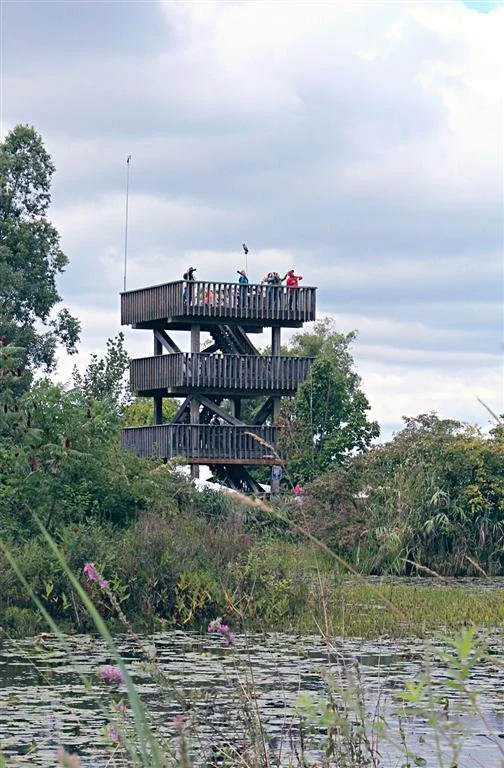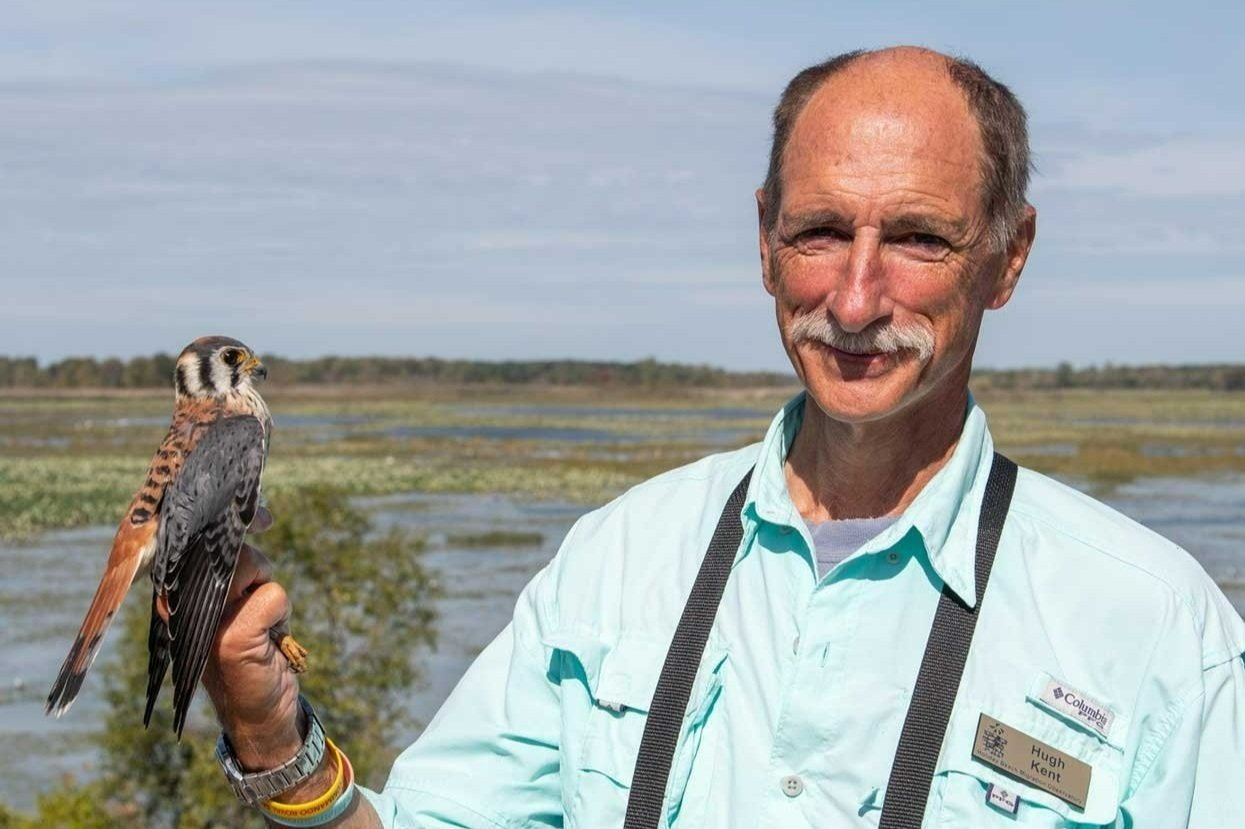by Anna Karch
Bird populations in Canada and across the globe have been in decline for a few decades now, some species falling faster than others, with about 3 billion less birds as compared to the 1970s. Birds are sensitive to changes in the environment, which means they can tell us a lot about habitat health; though their numbers are subsequently also prone to natural fluctuations. The current disconcerting, large-scale declines of bird populations and the rapid loss, fragmentation and degradation of native habitats show that the need for extensive bird monitoring programs is greater than ever.
This is where charitable organizations like the Holiday Beach Migration Observatory (HBMO) play an irreplaceable role. They are headquartered at the Holiday Beach Conservation Area (HBCA) in the Big Creek Marsh watershed, and are wholly dedicated to the “study and long-term monitoring of migratory bird populations during the spring and fall seasons” (HBMO, 2022) . The Big Creek Watershed also has tremendous ecological value - it has been designated an Important Bird Area and is owned and operated by the Essex Region Conservation Authority (ERCA).
The HBMO strives to contribute to the greater understanding of migration and conservation of birds and insects and their habitats through their extensive research and education programs. Together with ERCA, the Holiday Beach Migration Observatory, will be hosting an event, the Festival of Hawks, on September 17th, 2022 in recognition of our unique wildlife and our role in preserving them.
Head over to Holiday Beach Conservation Area on September 17, 9am-3pm for the Festival of Hawks, an annual event organized by the Holiday Beach Migration Observatory and the Essex Region Conservation Authority. Watch thousands of birds of prey flying overhead and experience programs that cover a wide range of birding and local nature topics.
Photo credit: Gary Buchanan/HBMO
Our Unique Wildlife
“Birds are sensitive to changes in the environment, which means they can tell us a lot about habitat health; though their numbers are subsequently also prone to natural fluctuations”
According to Gina Pannunzio, ERCA’s Partnership and Outreach Coordinator, the Essex region is home to some of the rarest and most biodiverse wildlife in Canada, and “to exceptional wildlife spectacles that include: the spring bird migration through Point Pelee National Park and Hillman Marsh Conservation Areas, the endangered herptiles (reptiles and amphibians) of Pelee Island, the fall raptor migration through Holiday Beach, Ontario’s largest heronries (heron nesting grounds) located on the islands of Lake Erie, and the fall gatherings of butterflies.”
Unfortunately, many avian members of our local ecosystems are at risk due to various impacts of climate change.
A Bird’s Eye View: Why Counting Counts
Birds can tell us a lot about our environment.
Remember the canary in the coal mine adage? Due to their sensitivity to deadly carbon monoxide gas, canaries were carried into mines as alarms; when their singing stopped, it was a sign for miners to evacuate immediately (and get their canaries back to safety).
Of course, birds’ abilities as environmental indicators extend further, highlighting the importance of conservation projects aimed at monitoring them and their populations. Hugh Kent, President of the HBMO says, “Ideally we should conserve all endangered species as they are all part of the food chain and the degradation of the food chain will affect us as well as all other animals. Nature cannot take its course as humans have significantly disrupted natural processes. We are already in an age of increased extinctions due to the effect of human activities on the natural world.”
Effective monitoring programs can tell us about certain areas, changes in food availability, changes in the use or health of a habitat, among other things. Besides that, studying birds in particular is widely useful as birds are found almost everywhere on earth, they’re not so nuanced as to become impossible to tell apart, and they mimic trends seen in other wildlife groups.
Across Canada, rapidly declining numbers of shorebirds, grassland birds, and aerial insectivores—like the red knot, the greater sage-grouse, and the least fly catcher respectively—all point towards this habitat loss, habitat degradation, climate change, and loss of food source in our own communities.
Image credit: NABCI
Even without playing the role of economic indicators, birds are essential to human welfare. Whether they act as a living pest control, cleanup crew (scavengers), seed spreaders, etc., they provide invaluable ecosystem services.
HBMO’s Hawk Migration Counting
“Nature cannot take its course as humans have significantly disrupted natural processes. We are already in an age of increased extinctions due to the effect of human activities on the natural world”
At this time of year, the HBMO—ranked as the top hawk watching site in Canada by Audubon Magazine, and the third best in all of North America. — “runs hawk migration counting between September - November at Holiday Beach Conservation Area near Amherstburg, Ontario.” Hugh states that the birds are caught and tagged by members of HBMO so their travels could be documented and studied by researchers. This information helps them learn where they are coming from and where they’re going to, about their habitat and other things you can do to keep them coming back such as habitat restoration, enhancement and creation efforts.
What You Can Do
If you choose to attend the Festival of Hawks this year, you will have the opportunity to help support the conservation efforts directly by “adopting” a banded hummingbird or raptor and releasing them into the sky. The adopter gets to track their bird by being notified any time their adoptee is caught in North America.
Did You Know?
The Peregrine Falcon is the fastest bird in the world and the Ambassador Bridge is the only nesting site in this area (next closest is London).
The Peregrine Falcon has a great recovery story as it was wiped out in all of eastern North America due to DDT poisoning in the 1950s and 60s but has slowly reoccupied its range and expanded its population.
More generally, it’s important to stay informed. At the event specifically, there will be many opportunities to learn about conservation efforts and climate change - like at the Hawk Tower where official counters will be available to provide interpretations of what’s going on in the sky.
Other ways you can watch out for our avian friends is by creating healthy environments for them to rest and nest during migratory seasons - chemical-free gardens of native shrubbery, grasses and dense foliage (especially berry bushes) provide ample opportunities to forage and find shelter, especially insects which are very important as food sources for small birds, which are then in turn food for the raptors. Keep bird feeders and water fountains clean, and follow any local seasonal feeding guidelines. Taking up bird-watching is an excellent way to spend time in nature, observe local avian biodiversity, enjoy an interactive activity with your kids, and even become a citizen scientist by submitting bird observations and joining thousands across the world in monitoring birds. Whether you’re a novice or a pro, birdwatching is a gift that keeps on giving the more time you put into it.
The internet also provides many opportunities to stay updated on the status of climate change and its effect on our world and local communities. Follow sites and pages you trust to stay updated. Most importantly, make a change; whether you’re growing your own food, choosing to travel (carbon) light, or making any other sustainable daily changes, every bit matters when it comes to tipping the scales in their favour.
In the end, just as 1960s “dead” Lake Erie made a miraculous recovery following binational cooperation, our sustained efforts and organized action will help preserve the environment - so keep soaring on that sustainability high!







![Birds “are caught and tagged by members of HBMO so their travels [can] be documented and studied by researchers” (HBMO, 2022).](https://images.squarespace-cdn.com/content/v1/594e8ec0db29d60c596f0cc3/1663034239401-44GH6VRJ4FSA1F0GYUWN/IMG_3886.jpg)





